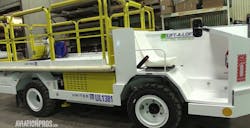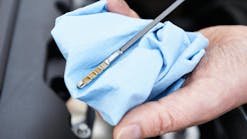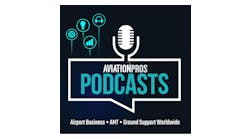IS ONLINE TRAINING THE FUTURE?By Emily Refermat
According to your responses in an email training survey reported in the May/June issue of AMT roughly 18 percent of mechanics utilize online or long-distance learning, which is far less than any other training method (with the exception of colleges). Since most companies pay for training (more than 83 percent according to that same survey) and A&P's receive 25 or more hours of training a year to maintain their skills and professionalism, training becomes quite an expense. Add to that the travel and living expenses that go beyond the initial cost of training and you've created a huge expense.
As aviation companies cut costs and look at every dollar they spend, online resources may be the solution to dealing with small and continually shrinking travel and expense budgets for training.Self-paced
Free training opportunities are popping up on web pages and from manufacturing companies alike. Northrop Rice has a division for free aviation training that most mechanics are aware of called Aerolearn.com. The reviews of Aerolearn.com, and training like it, are mixed. They provide valuable, free information on a variety of topics and are great for personal improvement. However, as they exist right now, there is no way to measure their effectiveness. For Aerolearn.com in particular there is no way to track the hours of training taken or how much effort the person put into the training or what that person retained from the lesson. Aerolearn.com relies on the honesty and desire of the individual mechanic taking it and is self-paced. Adding an assessment at the end of the course and defining a number of hours to the course information might allow for more regulation and monitoring of the training making it easier to award the appropriate level of credit. However, there is controversy about whether this additional regulation is needed when it doesn't exist in the classroom version of training. Although there is room for improvement, this form of training is valuable.
Often skilled mechanics who become maintenance managers lack the management
skills to create better morale and more efficient work practices. The new maintenance manager could log on to an Aerolearn.com and look up those soft skills and take the course on interpersonal managing skills or communication. Even if you're not a manager, the human factors training and professionalism are great courses to keep you up to date on your soft skills training for free.
So what else is available? Besides the self-paced and self-regulated training programs on the web FlightSafety International now offers two different online training programs that solve the problems of assessment and number of hours.Synchronous
On the market right now FlightSafety International has what Nick Sergi, FlightSafety's director, maintenance training services, calls a synchronous training course. By synchronous, Sergi explains, the instructor and the students are online at the same time. In fact the instructor might be in U.S. Central Standard Time getting on line at 10 a.m. An A&P from the East Coast of the United States will be logging on at 11 a.m., California at 8 a.m., and Asia a days difference. He goes on to explain that "time zones really don't make a difference if people want to set aside the time to take the training."
These synchronous classes usually occur twice a day, so if you miss the
first one, you have an opportunity to catch the second. This is important since you will not be able to complete the course unless you attend every session. There is usually a 10 to 12 student maximum, Sergi explains, although that is a function of the instructor. A single instructor needs to teach as well as monitor the progress and answer questions from the students during the session. There can be more students with more than one instructor. In some sessions there is an instructor who teaches and another who monitors the students.
FlightSafety currently uses this type of synchronous training for many of its in-house SAP training for its employees. It has been very successful says Sergi. The course offered for the A&P is "principles of troubleshooting online" and is exactly the same course you would get if you attended it in a classroom covering the most logical approach to troubleshooting aircraft systems. However, when you take the course online it runs two hours a day for 10 days, compared to 2 1/2 days in the classroom. Why such a vast difference when the information is the same? Sergi explains that online or distance learning requires more discipline.
When traveling to a class you get in a car, possibly a plane, and go to class in a different environment. When utilizing computer training you need to find a quiet, isolated computer to learn at. Having to meet the other students and instructor online at a certain time does help, Sergi interjects, but it's a different experience from onsite training.Asynchronous
FlightSafety also offers an "Asynchronous" application, created originally for Raytheon, on CD assisted by the Internet for the King Air 200, ATA spec 104, levels 1, 2, and 3 with a full maintenance initial (or just the first part 200 C90 350, ATA levels 1 and 2). Sergi explains that the program has a menu in the beginning and allows you to step through the aircraft systems one at a time at your own pace. At the end of each section, (once you've completed all the modules) there is an assessment that tests you on your knowledge. The results of these assessments are sent to FlightSafety over the Internet and kept in the records in order for you to be recognized for the training. There is also a chatbox where you can ask questions as you go along and receive an answer within 24 hours.
The complete King Air 200 CD contains 60 hours worth of training materials including inspection manuals. Since this is self-paced you can take as long as you want, but there is an overall time limit. After 120 days the program will cease to work. Sergi jokingly compares it to the self-destruct tapes in Mission Impossible.
Although FlightSafety is moving forward with plans for more training courses
via a "CD-Internet hybrid" as Sergi calls it, these courses will simply be another option for training. It will not replace classrooms or onsite training, but in an age of advancing computer technologies and a workplace attitude of trying to do more with less, we may see more training companies offering these online options to customers.
Additional ReSources
Aerolearn
1155 W. Arbor Vitae Street, Suite 115
Inglewood, CA 90301
(310) 568-4970
(310) 568-8542 Fax
www.aerolearn.com
FlightSafety International
600 S. Clyde Morris Blvd.
Daytona Beach, FL 32114
(800) 227-5656
(386) 226-4909 Fax
www.flightsafety.com






